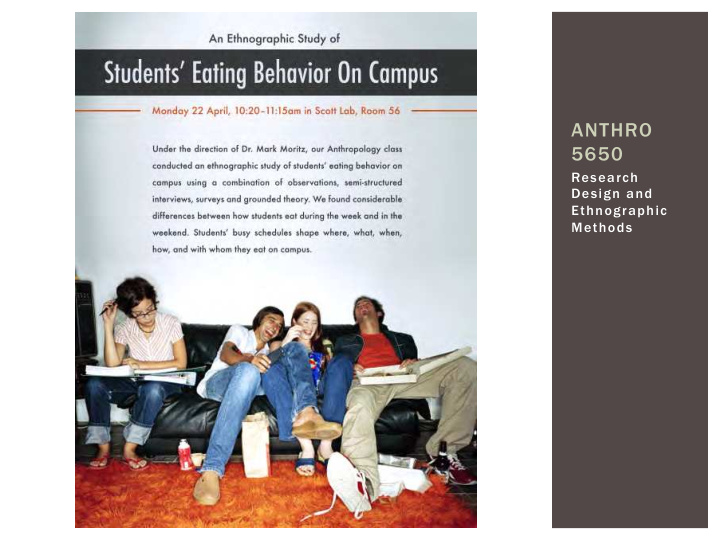



ANTHRO 5650 Research Design and Ethnographic Methods
OUTLINE 1. 1. Int Introduct oduction ion 2. 2. Et Ethnog hnographic re raphic resear arch 3. 3. Findings Findings 4. 4. Discussion Discussion
1 INTRODUCTION
PROBLEM STATEMENT ¡ The goal of this study was to come to a better understanding of the factors that shape students' eating habits at the Ohio State University.
COLLABORATIVE COURSE PROJECT ¡ ANTHRO 5650: Research Design and Ethnographic Methods. ¡ OSU campus as a natural laboratory.
LITERATURE REVIEW ¡ Studies of students’ eating behavior focus on: § Food choice (nutrition, calories, labels) § Health indicators (weight and BMI) § Dorm versus off-campus eating habits § Gender differences § "Freshman 15” ¡ The common methods are: § Surveys § Food diaries § Body measurements The Freshman Fifteen
2 ETHNOGRAPHIC RESEARCH
MULTIPLE POINTS OF VIEW (POV) Henrich, Joseph, Steven J. Heine, and Ara Norenzayan. 2010. Most people are not WEIRD. Nature 466(1 July 2010):29.
ETHNOGRAPHY
AN ETHNOGRAPHIC APPROACH ¡ IRA approach 1&2',3-$* !"#$%&'(#)* >&-$?)")* 45)#,6-7'&)* § Iterative § Recursive !',3-$* § Abductive !"#$%&'(#)* >&-$?)")* 45)#,6-7'&)* ¡ Considering meaning and context questions 8#3"9)(,:.(:,#%* +,-&).,"/()** @,':&%#%* 1&(#,6"#;)* -&%*.'%"&0* +A#',?* § POV2 à POV1 ¡ Increase understanding <:-&7(-76#* 8(-7)7.-$* <:#)7'&&-",#)* =-(-* -&-$?)")* and narrow focus using grounded theory 1&(#,/,#(-7'&* B,"7&0*C/* !"#$%&'$('&'$ Aga gar, Mic , Micha hael. (2006). An el. (2006). An Ethn Ethnogr ograph phy By An y By Any y Other Other Na Name. F me. For orum: Qua um: Qualita litativ tive Socia e Social R l Resea esearch. h.
CONCEPTUAL FRAMEWORK We used an ecocultural approach as conceptual framework: 1. Ecocultural context (e.g., schedule of classes, institutions, living arrangements) 2. Cultural models of development (e.g., ideas that students have about food, their goals) 3. Direct focus on activity settings (e.g., everyday eating routines in social settings).
OBSERVATIONS ¡ Observations of everyday eating activities in places on and around campus at different times during the week (n = 47).
SEMI-STRUCTURED INTERVIEWS ¡ Semi-structured interviews with descriptive questions to get students’ model of their own eating habits (n = 57). ¡ Typical descriptive grand-tour question: § Can you describe your typical eating habits throughout a school day? For example, when do you eat, what do you eat, where do you eat, with whom do you eat? Starting with the morning when you get up until at night when you go to bed?
ONLINE SURVEY ¡ Online survey using Google Drive (n = 356) to measure self-report of student eating behavior and eating preferences. § Non-random sample of OSU students with 81% female respondents.
3 FINDINGS
EATING ALONE OR WITH OTHERS
A BUSY SCHEDULE … 84% of students reported have a busy, very busy, or extremely busy schedule.
… MEANS EATING ALONE … 48% of surveyed students reported that they regularly or always eat alone. " I usually tend to eat alone just because it's kind of a spur of the moment, "hey "A lot of my lunches I'm kind of hungry and I and dinners end up have 20 minutes before being in class, so I class.” just eat alone." "During the week-alone. Our schedules are pretty busy you know. If it's in between classes, I usually eat by myself."
… BUT EATING ALONE IS AWKWARD … "I feel like you have to get used to it, like the first few times you do it, you're like - oh my gosh this is so weird." "I like can't do it, and it's really strange because, like, I was an "I'd probably be on my only child so I was alone a lot, phone [when eating but eating alone I cannot do it. I alone], just to not look just can't do it." super awkward."
… BUT STUDENTS LEARN TO COPE Using mobile technology Through experience Freq equen uency of cy of Awkw wkward sca d scale le ea eatin ting a g alon lone e (5=mor (5=more a e awkw wkward) d) Never 3.2 Occasionally 2.7 Regularly 2.6 Always 2.2 Spearman’s R = -0.173, p = 0.005
EATING ON WEEKENDS IS DIFFERENT "On weekends, I eat in groups. "Yeah, if you eat with a group, Never alone." people will talk and you will lose much time, especially on weekdays. But on weekends it doesn't matter - I think." "During the week alone...But on the weekends I'll go with friends or roomates [to eat]."
DIFFERENCES IN EATING HABITS When When I ea I eat with o t with other thers s When When I ea I eat a t alon lone e P- P-level I eat more 3.05 2.99 NS I enjoy my food more 2.67 3.11 P<0.001 I eat more slowly 2.51 3.51 P<0.001 I am more aware of manners 2.12 3.57 P<0.001 I use my phone less 1.66 4.10 P<0.001 1 = strongly agree 2 = agree 3 = neutral 4 = disagree 5 = strongly disagree Kruskal-Wallis Test (Nonparametric ANOVA)
4 DISCUSSION
THEORETICAL IMPLICATIONS 1. To better understand students’ eating behavior we need to use a holistic approach that includes observations in natural settings and students’ cultural models. 2. It also requires a theory of human behavior that takes into account the habits, constraints, and emotions that shape how students experience and make decisions about eating.
PRACTICAL IMPLICATIONS Option 1 Option 2 ¡ Individual work spaces with ¡ Seating arrangements that electrical outlets and facilitate conversations with internet in restaurants so others that promote “civility that students can work and and common purpose”. socialize using FaceTime.
THANKS Questions?
THE END
Recommend
More recommend